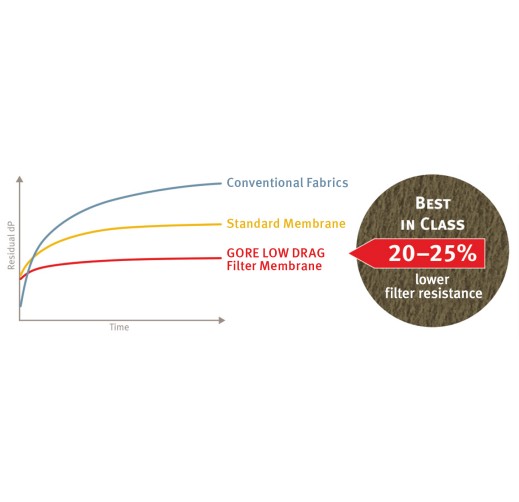Dust removal : GORE® LOW DRAG Filter Bags
Technology / Service Summary
Gore’s new materials are inherently less resistant to airflow and are therefore more efficient with respect to the amount of energy required to drive air through them during filtration.
Purpose
for dust removal with some co-benefits
Feature
Gore’s new materials are inherently less resistant to airflow and are therefore more efficient with respect to the amount of energy required to drive air through them during filtration. The key is improved cleanability, without sacrificing durability or particle capture efficiency.
Effect
The GORE LOW DRAG Filter Bag balances this filter performance through the simultaneous optimization of attributes hugely important to many industries:
# Increased fan energy efficiency
# Increased flow capacity
# Increased bag life due to reduced cleaning
# Improved product capture efficiency
# Reduced emissions
These attributes enable Gore’s solutions to deliver the lowest total cost of ownership available in a filtration system.
Controlled Substance
Reference
Applicable Regions / Countries
- Japan
- Southeast Asia
- Central/South Asia
- China/ East Asia
- Middle East
- Africa
- Oceania
- Europe
- Central/South America
- ASEAN countries
Indonesia,Cambodia,Singapore,Thailand,Philippines,Brunei Darussalam,Viet Nam,Malaysia,Myanmar,Lao PDR
Accomplishments
As the original inventor of membrane-based industrial filtration solutions, we continually push the envelope of innovation in the waste-to-energy industry. As a result, we’ve developed a suite of high-performance filter bags that address the industry’s and our customers’ needs. Across our solutions, reliability is the Gore standard — as is the long product life our customers have come to expect.
Related SDGs Goals
- 7. Affordable and Clean Energy
- 9. Industry, Innovation and Infrastructure
- 11. Sustainable Cities and Communities
- 12. Responsible Consumption and Production
Notes
Gore’s new materials are inherently less resistant to airflow and are therefore more efficient with respect to the amount of energy required to drive air through them during filtration. The key is improved cleanability, without sacrificing durability or particle capture efficiency.





